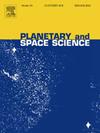基于RA-SAR模型的月球冷斑陨石坑高分辨率岩石丰度推算
IF 1.7
4区 物理与天体物理
Q3 ASTRONOMY & ASTROPHYSICS
引用次数: 0
摘要
月球表面岩石丰度分布对了解月球地质演化具有重要意义。本研究主要利用Mini-RF (Miniature Radio Frequency)合成孔径雷达(SAR)数据推导月球冷斑陨石坑的高分辨率RA数据。首先,对SAR数据进行地形校正。其次,利用与Mini-RF SAR图像分辨率一致的光学衍生RA数据,研究Stokes参数(S1、S2、S3和S4)与RA之间的相关性。通过绘制散点图显示Stokes参数与光学衍生RA之间的关系,建立了很强的统计关联。最后,在此基础上,建立了基于回归的RA-SAR模型。该模型被应用于其他月球冷点陨石坑,以获得它们的高分辨率RA分布。实验结果表明,该模型对Diviner RA和光学数据进行了验证,结果精度很高。该研究为利用SAR数据推断月球表面岩石分布提供了一种新的方法,并为推进月球地质研究提供了有价值的见解。本文章由计算机程序翻译,如有差异,请以英文原文为准。
High-resolution rock abundance derivation of lunar cold spot craters based on RA-SAR model
The distribution of rock abundance (RA) on the lunar surface plays a pivotal role in understanding its geological evolution. This study focuses on the derivation of high-resolution RA data for lunar cold spot craters using Mini-RF (Miniature Radio Frequency) synthetic aperture radar (SAR) data. Firstly, terrain correction was applied to the SAR data. Secondly, the correlation between the Stokes parameters (, , , and ) and RA was examined using optically-derived RA data, which aligns with the resolution of the Mini-RF SAR images. By plotting scatter diagrams showing the relationships between the Stokes parameters and the optically-derived RA, strong statistical associations were established. Finally, based on these findings, we formulated a regression-based RA-SAR model. This model was applied to other lunar cold spot craters in order to derive their high-resolution RA distributions. The experimental results show that the model yields highly precise outcomes when validated against both Diviner RA and optical data. The study provides a new approach for inferring rock distribution across the lunar surface using SAR data, and offers valuable insights for advancing lunar geological research.
求助全文
通过发布文献求助,成功后即可免费获取论文全文。
去求助
来源期刊

Planetary and Space Science
地学天文-天文与天体物理
CiteScore
5.40
自引率
4.20%
发文量
126
审稿时长
15 weeks
期刊介绍:
Planetary and Space Science publishes original articles as well as short communications (letters). Ground-based and space-borne instrumentation and laboratory simulation of solar system processes are included. The following fields of planetary and solar system research are covered:
• Celestial mechanics, including dynamical evolution of the solar system, gravitational captures and resonances, relativistic effects, tracking and dynamics
• Cosmochemistry and origin, including all aspects of the formation and initial physical and chemical evolution of the solar system
• Terrestrial planets and satellites, including the physics of the interiors, geology and morphology of the surfaces, tectonics, mineralogy and dating
• Outer planets and satellites, including formation and evolution, remote sensing at all wavelengths and in situ measurements
• Planetary atmospheres, including formation and evolution, circulation and meteorology, boundary layers, remote sensing and laboratory simulation
• Planetary magnetospheres and ionospheres, including origin of magnetic fields, magnetospheric plasma and radiation belts, and their interaction with the sun, the solar wind and satellites
• Small bodies, dust and rings, including asteroids, comets and zodiacal light and their interaction with the solar radiation and the solar wind
• Exobiology, including origin of life, detection of planetary ecosystems and pre-biological phenomena in the solar system and laboratory simulations
• Extrasolar systems, including the detection and/or the detectability of exoplanets and planetary systems, their formation and evolution, the physical and chemical properties of the exoplanets
• History of planetary and space research
 求助内容:
求助内容: 应助结果提醒方式:
应助结果提醒方式:


